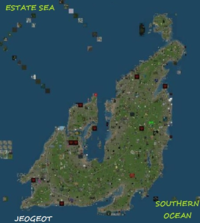Difference between revisions of "Jeogeot"
| Line 5: | Line 5: | ||
Jeogeot is a transition continent. It is the third historical mainland continint. The first two, that can be also called ''The Old World'', [[Sansara]] and [[Heterocera]], have a high Geographic diversity, many types of ground textures and a complex transportation system. The continents built after Jeogeot, that might be called ''The New World'', have a much lower Geographic diversity (a tendince for plains and low plateaus), less complex ground textures and a less developed trnsportation system. Jeogeot is somewhere between these two groups. The presence of some large plains in South make it look closer th the second group of continents and the percent of abandoned land is similar to that of the ''new world''. The lack of geographic and historical data might also place Jeogeot into the second group. On the other hand, the isolated mountains in sims like Somerset and Gorbash and the Ichelus volcano make at least parts of the continent look similar to the ''old world'' continents. | Jeogeot is a transition continent. It is the third historical mainland continint. The first two, that can be also called ''The Old World'', [[Sansara]] and [[Heterocera]], have a high Geographic diversity, many types of ground textures and a complex transportation system. The continents built after Jeogeot, that might be called ''The New World'', have a much lower Geographic diversity (a tendince for plains and low plateaus), less complex ground textures and a less developed trnsportation system. Jeogeot is somewhere between these two groups. The presence of some large plains in South make it look closer th the second group of continents and the percent of abandoned land is similar to that of the ''new world''. The lack of geographic and historical data might also place Jeogeot into the second group. On the other hand, the isolated mountains in sims like Somerset and Gorbash and the Ichelus volcano make at least parts of the continent look similar to the ''old world'' continents. | ||
== History == | |||
First sims of this continent were built in december 20th, 2005. The first part was the Northern island, then the continent expanded to South. The construction halted for a few months (spring 2006), until the South-Western part was started. In that peroid of time, the Eastern part of [[Sansara]] was built. A second stop was in spring 2007, when the continent still had the central sims unfinished (in this time, [[Nautilus]] and [[Satori]] were built. The last sims were added in march 19th, 2008. It is unknown when Jeogeot lost the two sims in North. A timeline evolution of the continent is available here: [http://www.slmaps.com/] | |||
== Coordinates == | == Coordinates == | ||
Revision as of 11:40, 10 September 2013
Jeogeot is one of the mainland continents. It was first made as a Corean continent. However, today the population comes from worldwide and the most spoken language is English. Coastal regions are more populated, while in other, central regions (mostly in sims without road and water access) there are many abandoned parcels. In the North-East corner, two sims are missing. They existed in early maps.
Jeogeot is a transition continent. It is the third historical mainland continint. The first two, that can be also called The Old World, Sansara and Heterocera, have a high Geographic diversity, many types of ground textures and a complex transportation system. The continents built after Jeogeot, that might be called The New World, have a much lower Geographic diversity (a tendince for plains and low plateaus), less complex ground textures and a less developed trnsportation system. Jeogeot is somewhere between these two groups. The presence of some large plains in South make it look closer th the second group of continents and the percent of abandoned land is similar to that of the new world. The lack of geographic and historical data might also place Jeogeot into the second group. On the other hand, the isolated mountains in sims like Somerset and Gorbash and the Ichelus volcano make at least parts of the continent look similar to the old world continents.
History
First sims of this continent were built in december 20th, 2005. The first part was the Northern island, then the continent expanded to South. The construction halted for a few months (spring 2006), until the South-Western part was started. In that peroid of time, the Eastern part of Sansara was built. A second stop was in spring 2007, when the continent still had the central sims unfinished (in this time, Nautilus and Satori were built. The last sims were added in march 19th, 2008. It is unknown when Jeogeot lost the two sims in North. A timeline evolution of the continent is available here: [1]
Coordinates
The coordinates are shown in sims, in the same way they can be found for every sim from Gridsurvey [2]. The numbers are in this format: longitude (min - max) / latitude (min - max). Unfortunately, even if Jeogeot is the 3rd continent built, there is not a description with its geographic subdivisions. The Second Life Wikia (see link below) only describes 3 very small regions, in the North-East corner of the continent, leaving about 80% of the continent undivided. For Geographic reasons, the continental surface is split into some subdivisions, as seen below:
Continent: 1007-1039/897-938
Central Sea (Zebrasil): 1018-1023/908-917
North-West Island: 1014-1021/915-922
North Island: 1030-1038/933-938
Northern Peninsula: 1025-1039/922-932
Northern Sea Channel: 1022-1023/917-921
East Landmass: 1024-1036/910-921
South-East Landmass: 1024-1035/897-909
South Landmass: 1018-1023/898-907
South-West Landmass: 1007-1017/898-915
Statistics
Size in sims:775 (North-South 43, East-West 36)
Size in meters: 50.79 square km (167.97/9.22 km)
Maritime sims (complete flooded): 36
Coast sims (water access): 308
Dryland sims (no water): 431
Sims with road access: 251
Sims without direct access: 205
Population density: med-low
Useful links
http://secondlife.wikia.com/wiki/Jeogeot - Second Life Wikia about Jaeogeot
[3] - pictures
[4] - airports
[5] - Ichelus volcano
